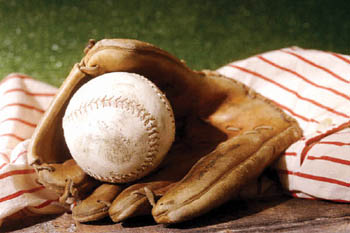![[Metroactive Features]](/features/gifs/feat468.gif)
[ Features Index | Silicon Valley | Metroactive Home | Archives ]

Biter Eye on the Ball A baseball guide for the rest of us By Traci Vogel SOME OF YOU may have noticed recently, perhaps following the absence of loved ones both at the dinner table and during the usual Sunday-afternoon laundry-folding extravaganza, that some sort of sports function seems to be occurring. Your keen skills of observation have served you well. It is, indeed, baseball season. Baseball is an ancient sport. Some think it was invented by the Mayans, who also invented the cartoon mascot. Early linguistic scholars spent decades trying to decipher these cartoon mascots before discovering that they actually represented early sports teams, such as the Yucatán Beheaders or the popular Xunantunich Virgin Heart-Renders. Since those bucolic Mayan days, baseball has come a long way. It has evolved into a sophisticated system of hitting a small round object with a long stiff object. Many laws of physics come into play during a baseball game. These laws have been assigned scientific names, such as the foul ball, the grounder, the knuckle ball and the dinger. The best method for understanding baseball is not to try so hard right away. Be aware that there are two teams and that each team is represented by a different color of uniform. The people in the black-and-white striped uniforms are not on a team. The people in the peanut vendor uniforms are not on a team. None of the spectators wearing uniforms are on a team, no matter how authoritatively they might address the coach. The people in the dark-blue uniforms arresting the screaming drunken spectators are not on a team. Do not attempt to cheer them on. Everyone else is on a team. Each member of the team is assigned a position. When one team is at bat, the members of that team will wield the large stiff object, while the members of the opposing team throw the small round object. Some running may occur; do not be alarmed by this. The entire purpose of the game is that one team keep the small round object close, while the other tries to keep it far away. Points are awarded according to the various laws of physics previously described. The most important member of either team is the pitcher. This is the person standing on the mound in the middle of the field, alternately caressing and spitting on the small round object, and occasionally throwing it away. The pitcher has a conjoined twin who was separated from him at birth. This separated twin is known as the catcher. The catcher received less of the shared facial tissue than his brother the pitcher and therefore must wears a mask. Throughout the game, the catcher will flash threatening gang signs at the pitcher. Do not be alarmed by this. Do not call in the men in the blue uniforms. You may also notice players standing at the fringes of the playing field, often looking bored. These players are known as the "outfielders," a term that is derived from the French outlier, which is defined as "a person who is excluded, or excludes himself, from some group; outsider." These outliers, or outfielders, often exhibit a hermitlike introspection, along with a lithe dancer's physique. When to cheer: There is only one time when it is appropriate to cheer during a baseball game, and that is when any of the spectators or players get into a fight. When to stop watching: It is inadvisable to stop watching a game until the post-game commentary has been under way for at least 45 minutes. When to swear: Swearing is encouraged any time during a game. Observe your fellow spectators in order to know which inflection (up or down) is appropriate at which time.
Send a letter to the editor about this story to letters@metronews.com. [ Silicon Valley | Metroactive Home | Archives ]
|
From the October 16-22, 2003 issue of Metro, Silicon Valley's Weekly Newspaper.
Copyright © Metro Publishing Inc. Metroactive is affiliated with the Boulevards Network.
For more information about the San Jose/Silicon Valley area, visit sanjose.com.